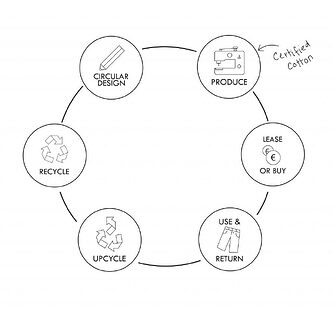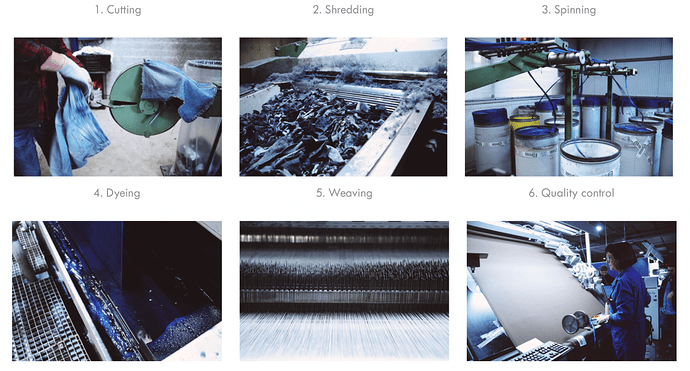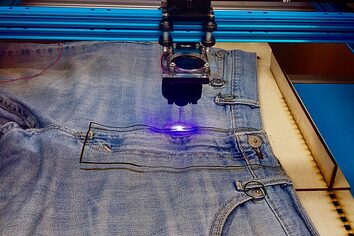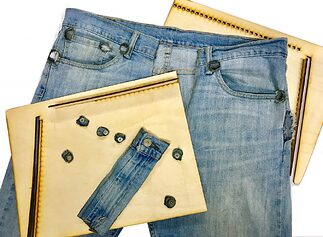(2016 Fall) Students: Sander Bal – Simon Navarro – Simon Boerwinkel – Marc Ziedses des Plantes
MUD Jeans Denim recycling and circular economy
MUD Jeans is a fashion brand company, selling jeans, shirts and sweaters. They are working towards a sustainable future with the circular economy at its center. The reduction of waste and pollution are central in the circular economy but fair wages and good working conditions for laborers in low-wage countries are equally important.
To achieve their goals, the jeans can be bought and handed in when they are worn out for a price reduction on a new pair of jeans, or the jeans can be leased for a year or more after which they will have to be returned. These old jeans can be recycled into new cotton fabric with which new jeans can be made.
Current Situation
The current recycling process is divided into 6 steps:
- Cutting: The metal parts (zippers and rivets) must be removed from the jeans;
- Shredding: The old jeans are processed back to cotton fibers;
- Spinning: For strength and performance, recycled fibers are blended with virgin cotton;
- Dyeing: Yarns are dyed using Indigo colour and water;
- Weaving: Yarns are weaved into one cloth;
- Quality Control: The final product is checked for visual defects and hazardous chemicals.
In the current situation, jeans are inserted by hand into a cutting machine which will cut the top of the jeans, where the metal parts are located. The metal parts need to be removed because they are a fire hazard if entered into the shredding machine.
The cutting of the tops causes a huge waste of material. Nowadays, 40% of the cotton of the jeans is thrown away, so a lot is wasted. This is also a slow process; indeed, it takes 10 seconds to take a pair of jeans, cut it, and throw it away.
Figure 1: Current process overview
Goal of this Project
The main goal of this project is to build a system able to locate and remove the metal parts on the jeans, with as little waste as possible.
The project will be focusing on the removing/discarding machine itself. The input of the jeans into the system doesn’t matter, it can be set in the machine by hand or via a conveyer belt. The output can also be changed if needed.
The parts that must be removed out of the jeans are:
- Rivets
- Buttons
- Zippers
The requirement we got from MUD Jeans, was to detect and remove all metal parts on the front of the jeans
The Solution
The complete solution consists of four subsystems:
- The transport system;
- The detection system;
- The cutting system;
- The operating system.
The transport system consists of a conveyor belt (blue) with specially designed carriers. The jeans are transported by the conveyor towards the robot until a sensor detects the jeans and stops the conveyor.
Figure 2: Setup overview
Figure 3: Carrier
The detection system uses a webcam to take a picture of the jeans. This picture is then processed in the software, specially written for this solution in Halcon. To ensure the correct light conditions, most of the area is closed off to ensure no unwanted light enters the area. Bright lights illuminate the jeans to make it easier to detect the rivets. After processing the information is sent to the robot.
Figure 4: Revit recognition
The gantry robot uses a laser to cut the areas designated by the detection software. After cutting the robot gives the signal for the conveyor to move and the whole process starts again.
Figure 5: Makeblock laserbot
An operating system is used to make all the separate components work together with at its base a computer.
Figure 6: Operating system
Major decisions we made during the project
- Due to the high cost it was impossible to use infrared lighting and a compatible camera for detection of the metal parts, which is most likely the best solution;
- Because of the use of normal lighting and a webcam, the project was scaled down and focussed mainly on the new type of jeans with reflective metal parts;
Conclusion
The main goal of building a proof of principle which could show that it is possible to detect and remove the metal parts with a minimum amount of waste has been achieved. Due to restrictions in time and money, the group has only focussed on the new type of jeans with reflective metal parts.
Goals were set high during the start of the project but due to the complexity of the vision problem and the use of an unknown robot only the original goals and client demands have been met.
Further research and experimentation will be necessary on the input and output of the system, as well as the use of infrared lighting and compatible camera for the detection system
Figure 7: Lasering of jeans Figure 8: End-result






